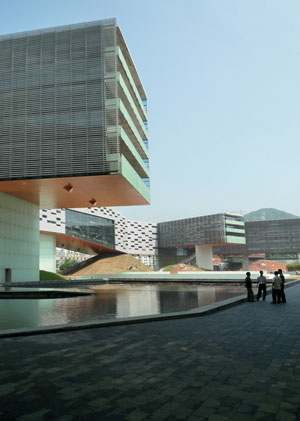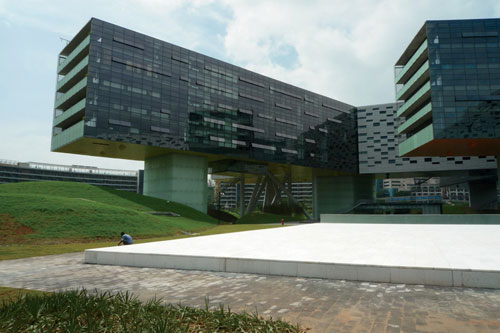Getting the Lay of the Land
 |
Pools are part of the landscaped area beneath the building. |
The building may be the first to combine a cable-stay system with a conventional column-and-beam concrete structure. "We decided on this system because of the desire for large spans and clear facades," says CABR's Congzhen. "A more traditional truss system would have obstructed the facades. This way, the main structure is inside the building." While other options might have been available using an entirely steel structure, this approach also saved money, since concrete construction is much less expensive in China.
Congzhen admits the construction process was difficult. The cores were constructed first, followed by the steel bottom slab, which was held up by supports from the ground until the cables were installed. Once the cables were in place, two concrete slabs of the upper structure were built and tension given to the cables. At this point, the ground supports were removed and the additional two or three upper slabs added. The cables - 511 1â„4-inch-thick flexible steel members - are enclosed in a steel tube to reduce vibration.
The building features cantilevers up to 82 feet, and spans twice that long. The underside of the structure, finished in bright colors, becomes its main elevation. Below it, the 560,000-square-foot tropical landscape features sunken gardens, courtyards, and large planted mounds (inside of which are various program spaces, such as a theater). In addition to the planted areas, several types of permeable pavement - local river stones, crushed gravel, open-joint stone pavers, grasscrete, and compressed sand pavers - are used to retain rainfall before secondary gutters redirect overflow into a series of ponds and wetlands that are planted with marsh grasses and lotus.
 |
The cable-stay structure permits open facades. |
Â
Though construction on the Vanke Center was recently completed, like many built projects in China (including Linked Hybrid), the program is still developing. "That is one of the challenges of building here," says Hu. "It is very dynamic and always changing." Regardless, a public path connects the different zones of the nearly 1,300,000-square-foot-complex. Currently, the Vanke Company's staff have moved into their offices, located in two of the branches.
The building's glass facade is protected against the sun and wind by porous louvers. Holl once again incorporates green strategies in this project, which is aiming for LEED Platinum certification, a first in China. The building has a green roof with solar panels and uses local materials such as bamboo (also highly renewable) for doors, floors, and furniture.
Also on the horizon for Steven Holl is another mixed-use development, which the architect calls Sliced Porosity Block, located in Chengdu, in China's central Sichuan Province. The project addresses many of the same issues of openness, connectivity, and sustainability that Holl has explored in Beijing, Nanjing, and Shenzhen - spreading his unique design approach to all areas of the vast country.








